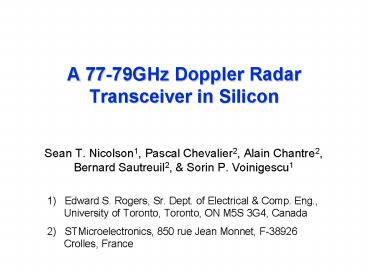A 77-79GHz Doppler Radar Transceiver in Silicon - PowerPoint PPT Presentation
Title:
A 77-79GHz Doppler Radar Transceiver in Silicon
Description:
A 77-79GHz Doppler Radar Transceiver in Silicon Sean T. Nicolson1, Pascal Chevalier2, Alain Chantre2, Bernard Sautreuil2, & Sorin P. Voinigescu1 – PowerPoint PPT presentation
Number of Views:52
Avg rating:3.0/5.0
Title: A 77-79GHz Doppler Radar Transceiver in Silicon
1
A 77-79GHz Doppler Radar Transceiver in Silicon
- Sean T. Nicolson1, Pascal Chevalier2, Alain
Chantre2,Bernard Sautreuil2, Sorin P.
Voinigescu1 - 1) Edward S. Rogers, Sr. Dept. of Electrical
Comp. Eng., University of Toronto,
Toronto, ON M5S 3G4, Canada 2)
STMicroelectronics, 850 rue Jean Monnet,
F-38926 Crolles, France
2
Outline
- Motivation and applications of Doppler radar
- Transceiver architecture and implementation
challenges - Circuit design and layout (top level circuits
blocks) - Fabrication technology and measurement results
- Detection of the Doppler shift
3
Doppler Radar Review
- Track range and velocity of a target without
amplitude info - Target range
- Target velocity
transmitted carrier (fC)
Doppler shift
hostile channel
fC Df
moving target (v)
transceiver
reflected signal
round trip delay (t)
4
Automotive Radar Applications
- Automotive applications of Doppler radar
- Transceiver requirements
- Long range, high PTX (not CMOS)
- On-chip DSP (need CMOS)
- low cost, single chip (many per car)
- Low area, low power (phased arrays)
- SiGe BiCMOS, direct conversion
5
Implementation of the Transceiver
- Single die for receiver and transmitter
- Tuned clock tree used to distribute VCO signal
- Frequency division at 77GHz using a static
divider - All circuit blocks use lt 2.5V supply (except
divider uses 3.3V)
6
Implementation of the Transceiver
- Single die for receiver and transmitter
- Tuned clock tree used to distribute VCO signal
- Frequency division at 77GHz using a static
divider - All circuit blocks use lt 2.5V supply (except
divider uses 3.3V)
7
Low-noise Amplifier
- 3-stage design, add R1 to de-Q the final stage.
- Noise Z matching inc. CPAD Nicolson et al.,
CSICS 2006 - All circuit blocks discussed in Nicolson et al.,
IMS 2007
250mm
1pF decoupling caps
8
Clock Buffer Design
- Cascode topology is chosen for the clock buffer
- high reverse isolation (i.e. low S12)
- Broadband, low gain (degeneration and resistive
loading) - Parameterized design of fixed size buffer to
variable size load - Q1, Q2, LC, and LE are fixed
- R1/R2 chosen for biasing, R1//R2 chosen to set Q
- LINT and C1 chosen to match to particular HBT size
matching interface
9
Layout for Isolation Bias Distribution
- Layout methodology systematically addresses
- Isolation of circuit blocks
- High-C, low-R, low-L power, ground bias planes
- N-well and p-sub contacts for isolation in the
substrate
10
Top Level Layout
11
Fabrication Technology
- Two technologies with identical BEOL
- wE 0.13mm with 170/200 GHz fT/fMAX
- wE 0.13mm with 230/290 GHz fT/fMAX
Technology info in P. Chevalier et al., BCTM
2005
12
Transmitter Output Power
- Transmitter POUT vs. LO and T (230/300GHz fT/fMAX
process)
13
Optimal Biasing for SiGe HBT PAs
- SiGe HBT power amplifier PAE, PSAT, and P1dB vs.
bias - All reach a maximum at the same current density
1.8V
1.5V
14
Receiver Conversion Gain
- Peak conversion gain of 40dB, -3dB bandwidth is
10GHz
83GHz LO
Conversion Gain dB
78GHz LO
81GHz LO
15
Receiver Conversion Gain
- IP1dB of -35dBm and OP1dB of 3dBm at 25C, 2.5V
supply - IP1dB of -30dBm and OP1dB of 0dBm at 100C, 2.5V
supply
83GHz LO
16
LNA Input Match
- S11 better than -15dB from 81GHz to 94GHz
- S11 does not degrade significantly with current
density
17
Receiver Noise Figure _at_ 1GHz IF
- JOPT is constant versus temperature ? bias with
const. IC - 3.85dB NF at 25C in receiver with 300GHz fMAX
HBT
81.6GHz LO
3.85 dB
18
Receiver Noise Figure versus IF
- Maximum NF of 4.7dB at 2.5GHz IF, 81.6GHz LO
19
Doppler Radar Experimental Setup
IA ACL 40dB
Bias
30Hz DC block
3kHzLo-Pass
BNC cables
Scope
110GHz probe cap
110GHz probe cap
15cm 110GHzcoax
4dB RX loss
Target 0.25m2 6m range
12dB TX loss
107dB channel loss
gt 40cm 110GHz coax
horn antennae(20dB gain each)
20
Doppler Radar Experimental Setup
21
Doppler Radar Experimental Setup
22
Doppler Radar Experimental Setup
23
Doppler Radar Experimental Setup
24
Example Doppler Signal
- 55Hz Doppler signal (target moving at 0.75km/h)
25
Doppler Radar Video
- Human target walking forward backward at
varying speed
26
Comparison To Other Work
- This work bottom row
27
Conclusions
- First single-chip silicon 82GHz direct conversion
transceiver - Fundamental VCO
- Verified to operate at 100C using 2.5V supply
(3.3V for divider) - Improved VCO will obtain improved performance
over temperature - Static frequency divider at 82GHz
- Successfully detected a 55Hz Doppler shift at 6m
range - 3.9 4.7dB noise figure with 82GHz LO and 0.5
4GHz IF - record for W-Band CMOS/SiGe receivers
28
Acknowledgements
- K. Yau for help with measurements
- STMicroelectronics for fabrication of circuits
test structures - J. Pristupa, and E. Distefano for CAD network
support - CITO NSERC for funding































